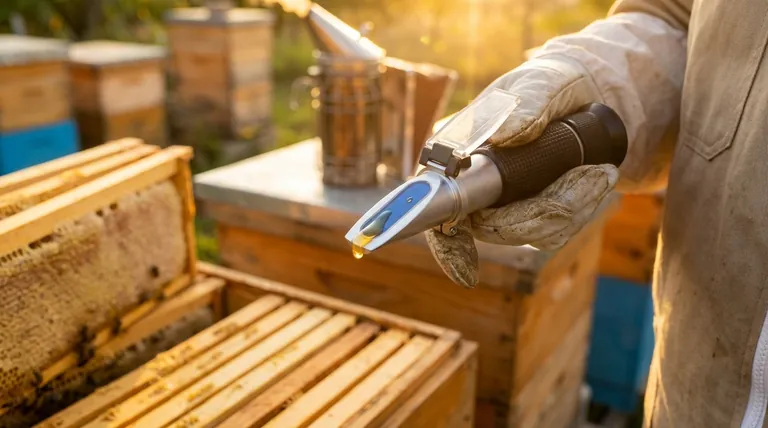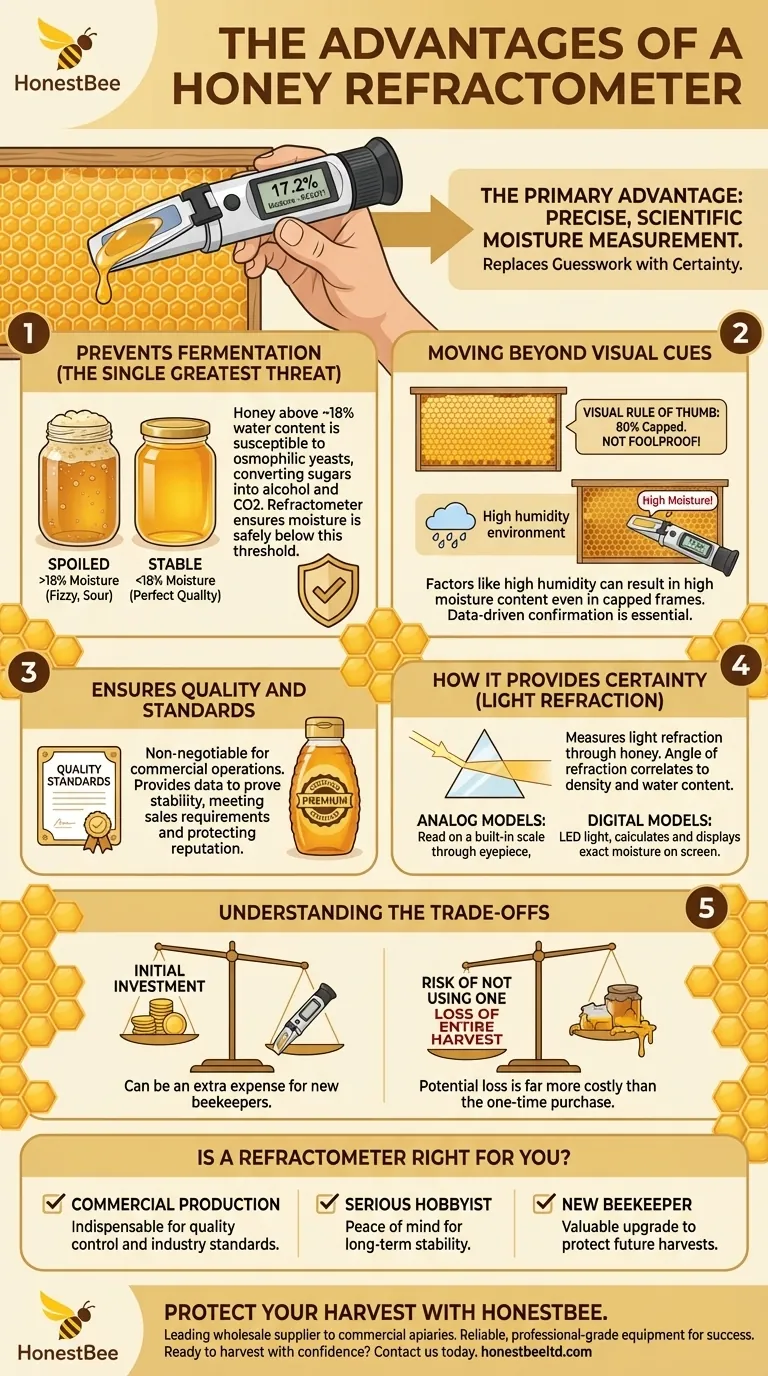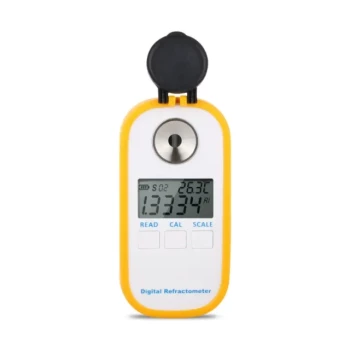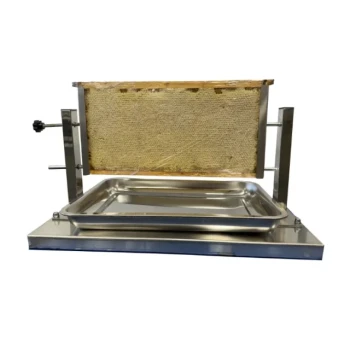The primary advantage of a refractometer is that it gives beekeepers a precise, scientific measurement of the water content in their honey. This single data point is the most reliable indicator of whether honey is ready for harvest and, crucially, whether it will remain stable and resist fermentation in the jar. It replaces guesswork with certainty.
A refractometer is an insurance policy for your honey harvest. By quickly and accurately measuring moisture levels, it removes the risk of bottling honey that will later spoil, protecting both your hard work and the quality of your final product.

Why Moisture Content is the Critical Factor
The single greatest threat to harvested honey is fermentation. A refractometer is the definitive tool for managing this risk by providing an objective measure of the honey's readiness.
The Danger of Fermentation
Honey with a water content above approximately 18% is susceptible to fermentation. Naturally occurring osmophilic yeasts can become active in this high-moisture environment, converting the sugars into alcohol and carbon dioxide.
This process results in honey that is fizzy, sour, and spoiled. A refractometer allows you to confirm the moisture is safely below this threshold before you ever uncap a frame.
Moving Beyond Visual Cues
A common rule of thumb for harvesting is to wait until the bees have "capped" at least 80% of the honeycomb with wax. While this is a good indicator, it is not foolproof.
Factors like high ambient humidity can result in honey with high moisture content even within a capped frame. A refractometer provides the definitive, data-driven confirmation that visual inspection cannot guarantee.
Ensuring Quality and Standards
For any beekeeper who sells their honey, meeting quality standards is non-negotiable. A refractometer is an essential tool for commercial operations.
It provides the necessary data to prove the honey is stable and meets the required moisture content for sale, protecting your reputation and your business.
How a Refractometer Provides Certainty
This simple device uses a reliable scientific principle to deliver fast and accurate results, making it an accessible tool for beekeepers at any level.
The Principle of Light Refraction
A refractometer works by measuring how much light bends, or refracts, as it passes through a thin layer of honey. The angle of refraction is directly correlated to the density of the liquid.
Since the primary variable affecting honey's density is its water content, the device can provide a precise moisture reading.
Common Types for Beekeepers
Beekeepers typically choose between two main types of refractometers.
Analog models are the most common. You place a drop of honey on the prism, close the cover plate, and look through an eyepiece toward a light source to read the moisture level on a built-in scale.
Digital models are even simpler. You place a drop of honey in a small well, and the device uses a built-in LED light source to calculate and display the exact moisture content on a screen.
Understanding the Trade-offs
While highly valuable, a refractometer is an additional piece of equipment. Understanding its context helps you determine its value for your specific operation.
The Initial Investment
For a new beekeeper, a refractometer can feel like an afterthought or an extra expense. The initial cost is a factor to consider when purchasing your startup equipment.
The Risk of Not Using One
The cost of a refractometer should be weighed against the potential loss of an entire honey harvest. Losing gallons of honey to fermentation is far more costly and disheartening than the one-time purchase of the tool.
Accuracy Requires Proper Use
Like any scientific instrument, a refractometer provides reliable data only when used correctly. This includes taking a representative honey sample from the frame and ensuring the device is properly calibrated according to its instructions.
Is a Refractometer Right for You?
The decision to invest in a refractometer depends on your beekeeping goals and the level of certainty you require.
- If your primary focus is commercial production: A refractometer is an indispensable tool for quality control and meeting industry standards.
- If your primary focus is being a serious hobbyist: This tool provides peace of mind and guarantees the long-term stability of the honey you store or give to others.
- If your primary focus is learning as a new beekeeper: You can start by relying on visual cues, but a refractometer is one of the most valuable upgrades you can make to protect your future harvests.
Ultimately, using a refractometer allows you to harvest with the confidence that comes from knowing your honey is perfect.
Summary Table:
| Advantage | Key Benefit |
|---|---|
| Prevents Fermentation | Accurately measures moisture to keep levels below 18%, the threshold for spoilage. |
| Replaces Guesswork | Provides scientific data beyond visual cues like capped frames for reliable harvesting. |
| Ensures Quality Standards | Essential for commercial beekeepers to meet sale requirements and protect their reputation. |
| Fast & Accurate | Uses light refraction for quick, reliable results with analog or digital models. |
Protect your harvest and ensure premium honey quality with the right tools from HONESTBEE.
As a leading wholesale supplier to commercial apiaries and beekeeping equipment distributors, we provide the reliable, professional-grade equipment you need for success. A refractometer is a critical investment in quality control, and we offer a range of trusted options to fit your operation.
Ready to harvest with confidence? Contact our expert team today to discuss your needs and discover how HONESTBEE's supplies can help you maximize the quality and value of your honey.
Visual Guide

Related Products
- Precision Honey Refractometer Instrument for Quality Assessment
- Digital Honey Refractometer for Precision Measurement of Optimal Honey Quality
- 8-Frame Electric Self-Reversing Honey Extractor Spinner for Commercial Honey Extraction Equipment
- HONESTBEE 72 Frame Industrial Electric Honey Extractor for Beekeeping
- Honey Concentrating Vacuum Heating Thickening Machine Dehumidifier for Honey
People Also Ask
- What are the benefits of using a Pocket Digital Honey Refractometer? Achieve Precision & Speed in Honey Quality Control
- What are the key points for proper usage of a honey refractometer? Ensure Accurate Moisture Readings Every Time
- What are the features of the Standard Refractometer for honey moisture content? Essential Tools for Quality Control
- What is a honey refractometer and what is its purpose? Ensure Honey Quality and Prevent Spoilage
- Why is a honey refractometer important for beekeepers? Ensure Quality and Prevent Fermentation



















